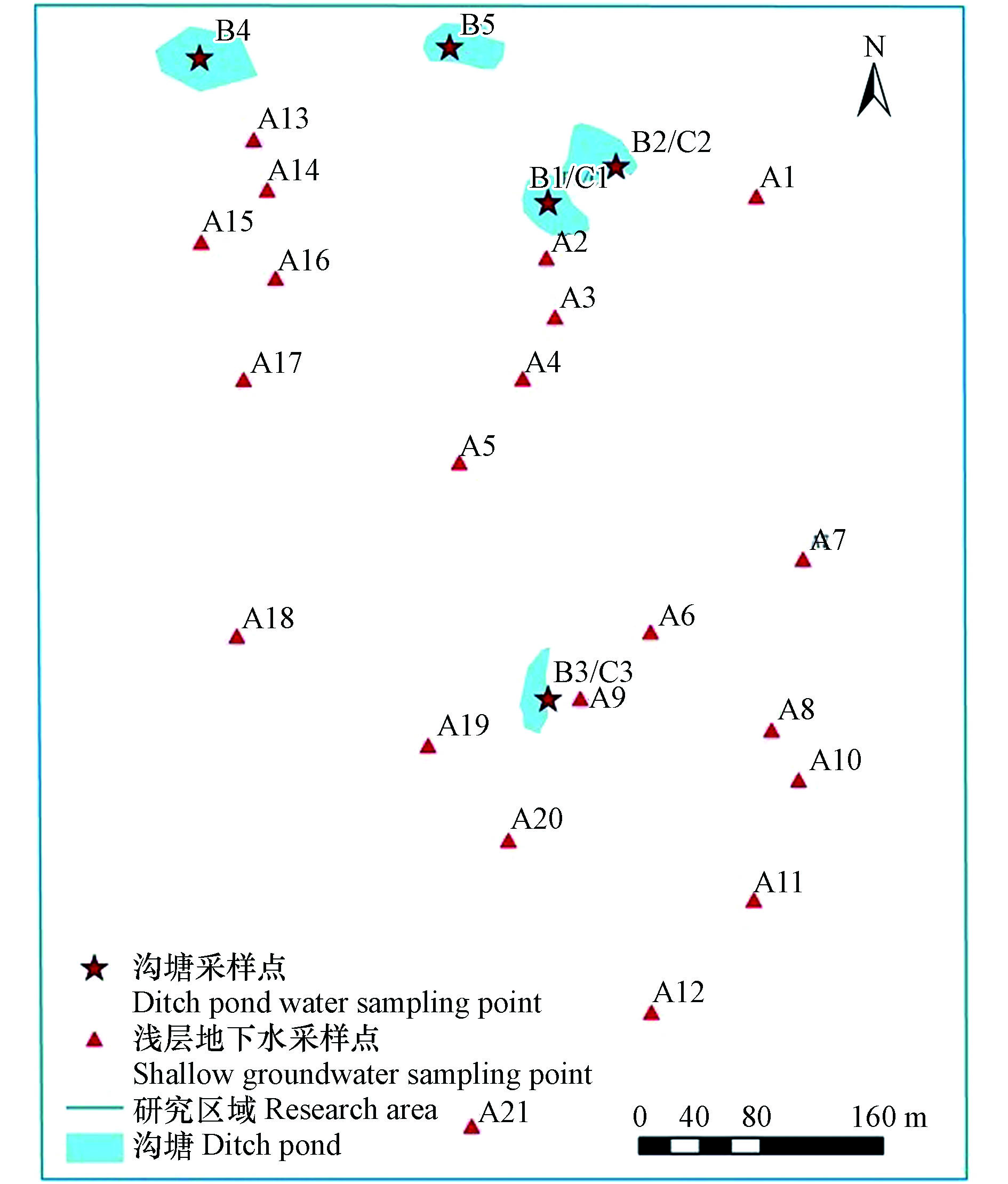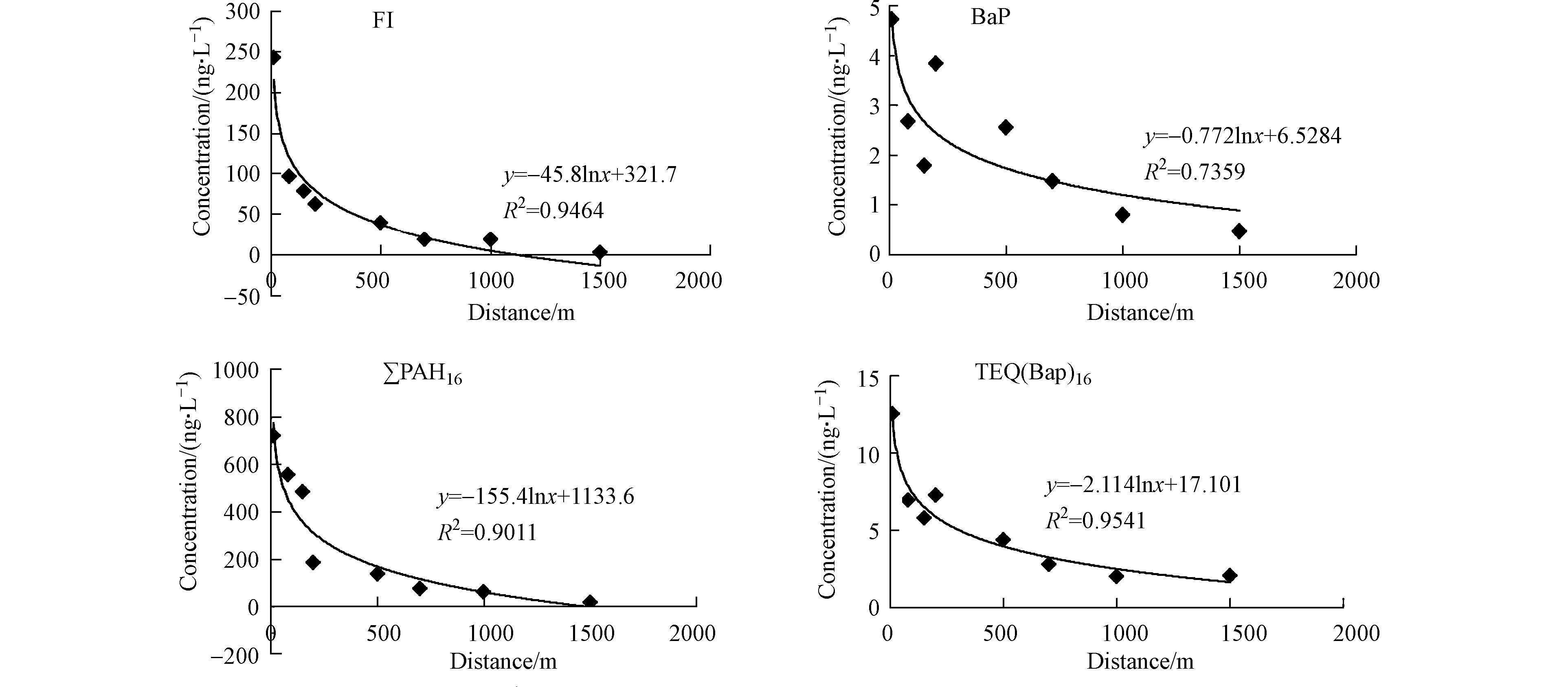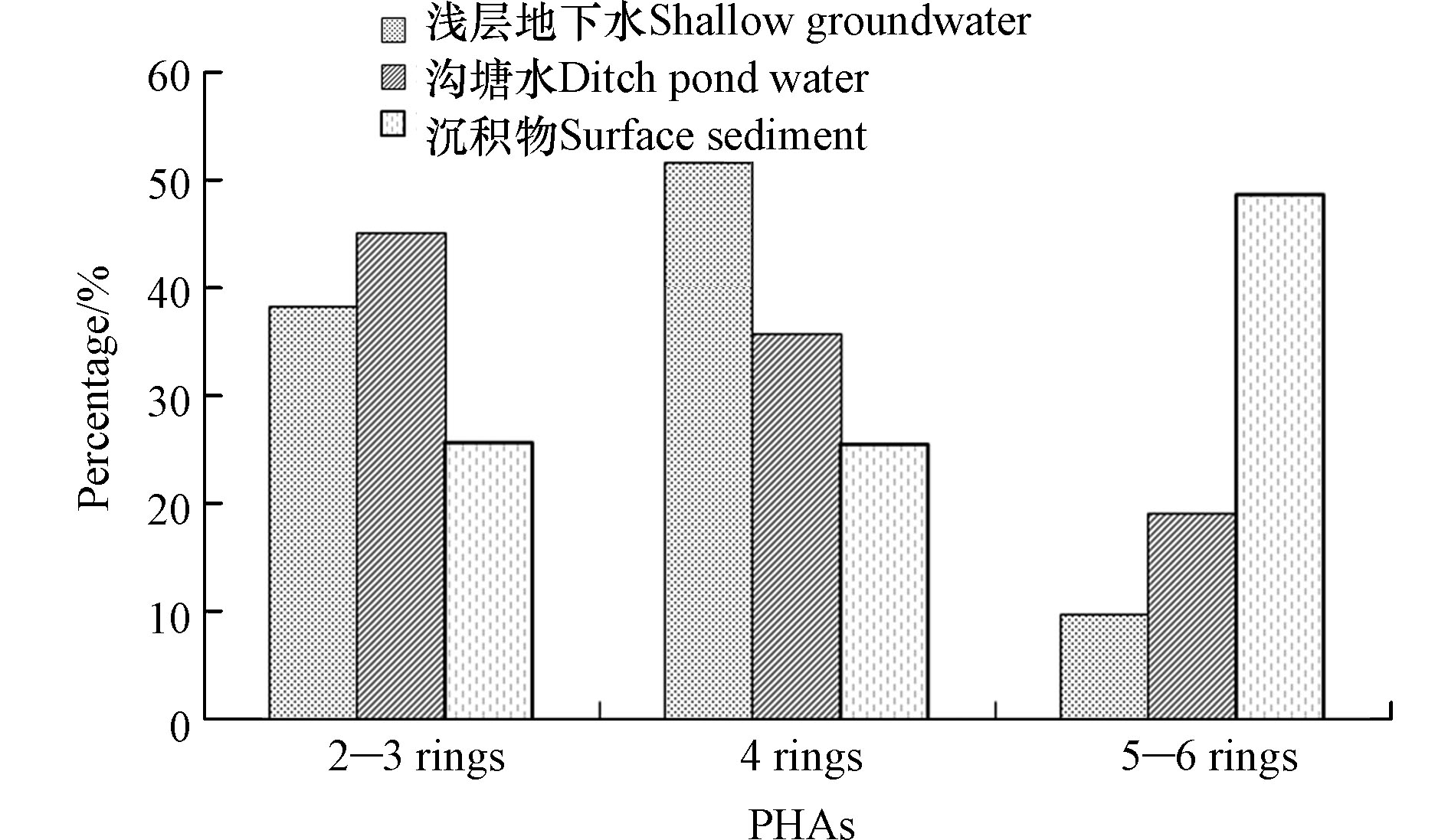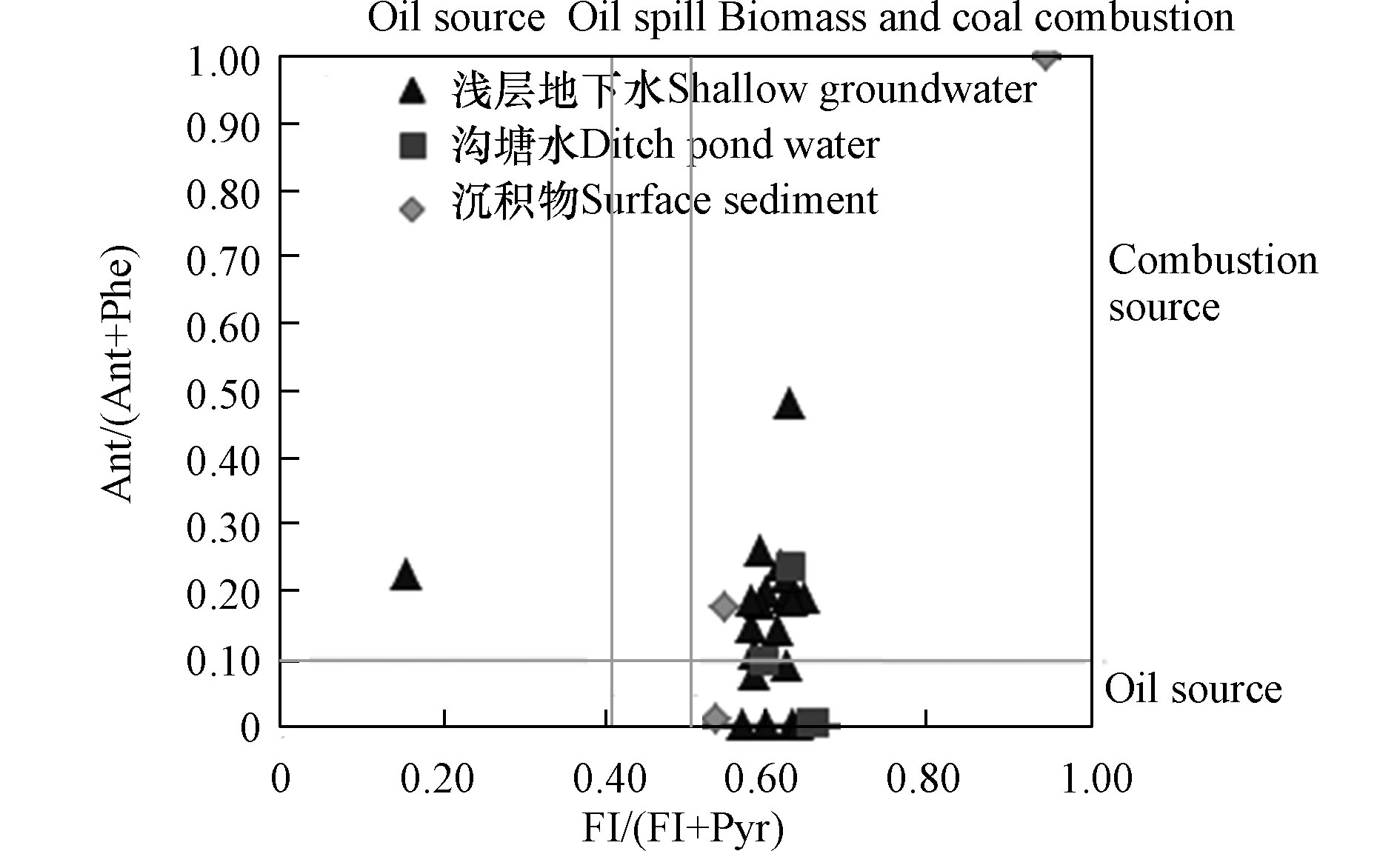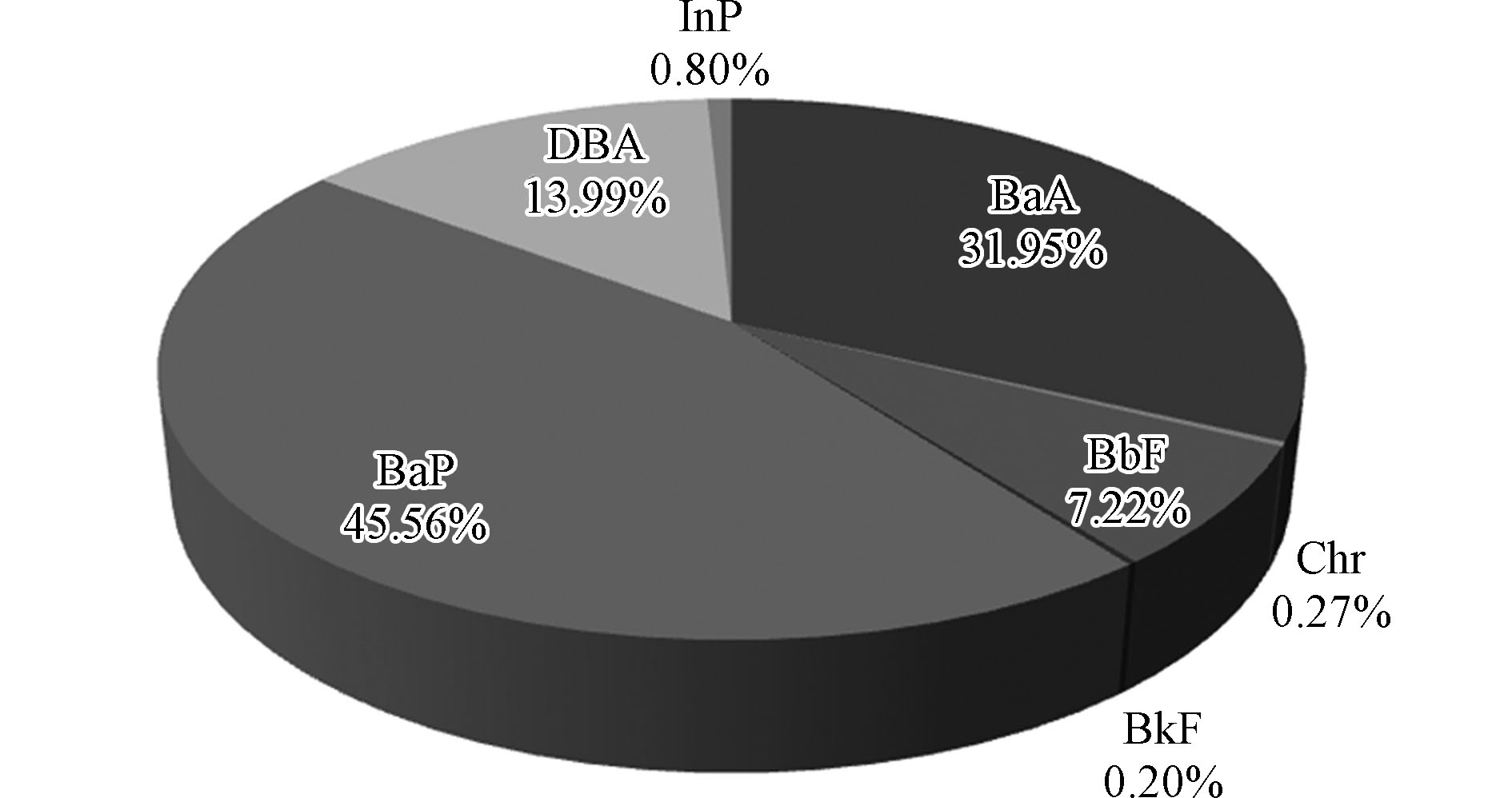-
多环芳烃 (polycyclic aromatic hydrocarbons,PAHs)是一类由2个及2个以上苯环组成的有机污染物,原型及其衍生物达400多种[1]。美国环保局(USEPA)将16种对人体健康危害较大的PAHs列入了优先控制污染物名单[2],其中苯并[a]芘(BaP)被确定为强致癌物质。
多环芳烃广泛分布在各种环境介质中。由于具有疏水性和亲脂性,PAHs在水中的溶解性较差,主要被悬浮颗粒物吸附,并可随悬浮颗粒物沉降至沉积物,沉积物中的PAHs经过解吸和再悬浮作用重新进入水体,成为新的污染源,同时通过生物积累和生物放大对生态系统和人体健康构成潜在危害。随着研究工作的广泛开展,不同类型地表水和沉积物中PAHs研究取得较大进展。我国对水体和沉积物中PAHs的研究主要集中在水库[3-4]、河流[5-7]、湖泊[8-10]、江海[11]及地下河[12]等,积累了大量数据;浅层地下水中PAHs的研究较少,主要集中在江苏[13]、河北[14]、安徽[15]和河南[16];然而在我国广大农村地区,沟塘数量众多且分布广泛。2016—2018年在淮河流域5个区县调查显示,49.7%(1272/2559)的农村居民报告住宅周边有沟塘,而且报告沟塘水体质量较差,24.3%(622/2559)的沟塘有异味。我国尚未开展农村地区沟塘水和沉积物中PAHs水平及其对周边浅层地下水影响的研究。
本文选取地处河南省西平县的5个沟塘水、3个沉积物和21户居民家中的浅层地下水作为研究对象,在2016年8月采集浅层地下水、沟塘水及沉积物样品,测定16种PAHs(各多环芳烃化合物的缩写详见表1)的含量,分析PAHs的空间分布特征和组分特征,评价农村地区沟塘水对其周边浅层地下水的影响,评估沟塘水和沉积物的生态风险及浅层地下水的人群健康风险。
-
研究区域位于河南省西平县的滞洪区内,浅层地下水埋藏深度为30—45 m,含水层中含水介质导水性差,地下水径流缓慢,径流方向由西北和西南向东南。
-
选择5个常年有水、周围居住人群较为密集的沟塘为研究对象,沟塘水体面积约为100—200 m2. 沟塘水体均呈现重度浑浊并伴有较强的嗅味,表面漂浮大量绿藻和生活垃圾(塑料、餐盒、秸秆、农药瓶等);调查的21户居民中有13户(占61.9%)报告会将生活垃圾和生活污水直接倾倒或排放到附近沟塘里,有9户(占42.9%)在沟塘里或周围养殖禽畜,其中2家直接将养殖废水排放到沟塘中。
-
在拟定沟塘和距离1500 m范围内采集水样,浅层地下水的采集以沟塘为原点向南或东南方向布设,在拟定点位附近的住户家中采样,沟塘水和沉积物的采集点位尽量布设在靠近沟塘中心部位,点位布设参见图1。共采集浅层地下水样21个、沟塘水样5个、沉积物3个,浅层地下水的平均井深为34 m(10.0—50.0 m)。采样方法参照《地表水和污水监测技术规范》(HJ/T91—2002)、《地下水环境监测技术规范》(HJ/T164—2004)和《土壤环境监测技术规范》(HJ/T166—2004)。采样器和盛水容器用稀盐酸 (优级纯)清洗,采样前用目标水样清洗3次。测量记录pH值和温度等基本信息后,用2.5L棕色广口瓶采集水样2瓶。以纯净水作为现场采样和样品运输保存的空白样。
-
Waters alliance e2695高效液相色谱仪,配备Waters 2998光电二极管阵列检测器、Waters 2475多波长荧光检测器和四元泵(美国Waters公司);Waters PAH C18色谱柱,4.6 mm×250 mm×5.0 μm(Part No. 186001265,美国Waters公司);Mettler Toledo XS205十万分之一分析天平;IKA MS3 basic旋涡振荡器(德国IKA);KQ-250DV超声仪(昆山市超声仪器有限公司);N-EVAPTM112氮吹浓缩仪(美国Organomation Associates公司);0.22 μm有机系针筒式微孔滤膜过滤器(天津津腾公司);50 mL聚丙烯离心管。
16种多环芳烃混合标准溶液(100 μg·mL−1溶于甲醇,美国Chem Service公司),存放于-20 ℃冰箱中。乙腈(色谱纯,德国Merck公司)。实验用水为Milli-Q Plus超纯水制备系统(美国Millipore公司)临用现制的超纯水(电阻率>18 MΩ·cm)。氮气(纯度大于99.999%)。
-
底泥样品在通风柜中自然干燥后磨至80目以下,干燥、阴凉密封保存。称取5 g样品于50 mL离心管(聚丙烯材质)中,加入8 mL乙腈,震荡摇匀。30 ℃下超声30 min后,4000 r·min−1离心2 min. 提取上清液至15 mL的离心管(聚丙烯材质),再用5 mL乙腈萃取残余淤泥,震荡摇匀,同样的条件下超声、离心,重复2次,提取液移到同一离心管中,氮吹浓缩至0.5 mL以下,再用乙腈定容至1.5 mL. 用振荡器将定容后的提取液摇匀,过0.22 μm的滤膜,存于2 mL的色谱瓶中,−20 ℃冷冻保存待测。
-
取1000 mL沟塘水或浅层地下水样品缓慢加入经二氯甲烷、甲醇活化的C18 SPE小柱过滤,小柱4℃冰箱保存。用13 mL甲醇洗脱,经氮吹浓缩至0.5 mL以下,加入3 mL乙腈,氮吹浓缩至0.5 mL以下,再精确定容至0.5 mL,存于2 mL的色谱瓶中,−20 ℃冷冻保存待测。样品实行平行操作测定。
-
采用乙腈-水梯度洗脱,进样量为20 μL,以色谱保留时间和各通道响应信号的一致程度定性,采用外标法峰面积定量。分别进行高、低浓度的加标回收试验,相对标准偏差(RSD) 为5.2%—8.6%。试验结果满足样品分析质量控制的要求,表明分析方法准确可靠。
-
采用SPSS 10.0进行数据的处理及相关统计分析.
-
浅层地下水、沟塘水及沉积物中PAHs含量、TEQ(BaP)(Toxic Equivalent Quantity, BaP毒性当量浓度)如表1所示。
沉积物中PAHs单体的检出率均高于浅层地下水和沟塘水。浅层地下水中,∑16PAHs(16种PAHs总量)为219 ng·L−1(8.39—1234 ng·L−1),其中Phe、Fl和Pyr对∑16PAHs的贡献大,合计占比为60.4%,w(Bap)(Bap的质量分数)为2.72 ng·L−1 (0.164—17.3 ng·L−1),其中1个点位高于我国地下水环境质量标准(GB /T 14848—2017)中Ⅲ类水质规定的限值(10 ng·L−1),超标倍数为0.733倍,与国内其他区域的研究结果相比较发现,该研究中浅层地下水中∑16PAHs和w(Bap)较低;沟塘水中,∑16PAHs为317 ng·L−1 (15.4—1372 ng·L−1),同浅层地下水一样,Phe、Fl和Pyr对∑16PAHs的贡献大,合计占比为55.8%,w(Bap)为11.1 ng·L−1 (0.0420—55.0 ng·L−1),其中1个样品高于我国地表水环境质量标准(GB 3838—2002)限值(2.8 ng·L−1),超标倍数为18.6倍;沉积物中,∑16PAHs为256 ng·kg−1 (101—458 ng·kg−1),其中DBA、Fl、BP、Pyr和Chr对∑16PAHs的贡献大,合计占比为59.7%,w(Bap)为16.0 ng·kg−1 (2.18—41.4 ng·kg−1)。
国际癌症研究机构(IARC)划定7种致癌性PAHs[17]。本研究浅层地下水中,这7种PAHs的质量分数(∑7PAHs)为40.0 ng·L−1 (3.36—298 ng·L−1),占∑16PAHs的18.3%;沟塘水的∑7PAHs为99.7 ng·L−1 (2.84—414 ng·L−1),占∑16PAHs的31.5%.;沉积物的∑7PAHs为133 ng·kg−1 (21.9—191 ng·kg−1),占∑16PAHs的52.0%。
采用毒性当量因子计算浅层地下水、沟塘水及沉积物中PAHs的TEQ(BaP),结果显示,浅层地下水中,TEQ(Bap)7为5.77 ng·L−1 (0.727—39.8 ng·L−1),TEQ(Bap)16为6.09 ng·L−1 (0.763—41.8 ng·L−1);沟塘水中,TEQ(Bap)7为27.5 ng·L−1 (0.568—83.1 ng·L−1),TEQ(Bap)16为28.0 ng·L−1 (0.589—85.3 ng·L−1);沉积物中,TEQ(Bap)7为75.6 ng·kg−1 (4.01—167 ng·kg−1),TEQ(Bap)16为76.0 ng·kg−1 (4.16—167 ng·kg−1). BaP含量、TEQ(BaP)含量、∑7PAHs占比依次为:沉积物>沟塘水>浅层地下水。
-
图2为沟塘1南向浅层地下水中PAHs单体的情况. 可以明显看出,距离沟塘越近,浅层地下水中PAHs含量越高,其中Fl的相关系数为0.9464,BaP的相关系数为0.7359,∑16PAHs的相关系数为0.9011,TEQ(BaP)16的相关系数为0.9541,表明沟塘水质对浅层地下水中PAHs的影响较大。
-
环境中PAHs的来源可分为天然和人为两种,绝大部分环境中的PAHs都与人类的生产生活紧密相关[18],其中,人为来源主要包括未经燃烧的煤和石油类产品(如石油挥发和泄漏、公路建设材料等)和各种不充分燃烧(如机动车尾气的排放、工业炼焦、电解铝、炼油、火力发电、煤炭、秸秆与薪材燃烧和吸烟等)。不同分子量的PAHs在土壤中的分布与其来源密切相关[19]。高环(4环及以上)PAHs主要来源于煤和石油类等化石燃料的高温燃烧,低环(2—3环)PAHs主要来源于有机物的低温转化和石油产品的泄露[20-22]。因此通过不同环数PAHs的分析比较可以解析其来源。该研究将16种PAHs单体分为2—3环、4环、5—6环3组进行分析比较(见图3)。浅层地下水PAHs组分中,2—3环PAHs占38.42%(9.63%—79.27%),4环PAHs占51.78%(17.36%—79.80%),5—6环PAHs占9.80%(1.60%—28.32%);沟塘水中2—3环PAHs占45.09%(18.55%—68.12%),4环PAHs占35.80%(21.63%—63.40%),5—6环PAHs占19.11%(8.31%—42.29%);沉积物中2—3环PAHs占25.74%(7.69%—54.80%),4环PAHs占25.57%(9.78%—42.45%),5—6环PAHs占48.69%(20.73%—82.53%)。从整体来看,浅层地下水中PAHs以4环居多,沟塘水中PAHs以2—3环居多,沉积物中PAHs以5—6环居多. 5—6环PAHs占比依次为沉积物>沟塘水>浅层地下水,说明PAHs在环境介质之间迁移分配的过程中,具有致癌性的5—6环PAHs化合物更容易存蓄在沉积物中。在采样过程中观察到从事家庭养殖活动的沟塘占40.00%,PAHs亲脂疏水特性使其可以在生物体内大量富集,通过食物链最终进入人体,从而对人体健康产生影响,因此需要对沟塘PAHs污染开展防治工作,特别需要对日积月累堆积的含高环的致癌性PAHs较多的沉积物加以治理。
-
Ant/(Ant+Phe)和Fl/(Fl+Pyr)的比值可用来判断环境中PAHs污染物的来源[23-25]。研究表明[25],当Ant/(Ant+Phe)比值小于0.10为石油源,大于0.10为燃烧源;Fl/(Fl+Pyr)比值小于0.40,表明PAHs主要来自石油源,大于0.50表明PAHs主要是生物质和煤炭的燃烧源,介于0.40—0.50则是石油燃烧源。图4为浅层地下水、沟塘水及沉积物中PAHs的Ant/(Ant+Phe)和Fl/(Fl+Pyr)分子比率图,浅层地下水中Ant/(Ant+Phe)比率为0.16(0.00—0.48),沟塘水为0.07(0.00—0.23),沉积物为0.40(0.01—1.00);浅层地下水中Fl/(Fl+Pyr)比率为0.59(0.15—0.64),沟塘水为0.64(0.60—0.66),沉积物为0.68(0.54—0.95)。除了浅层地下水一个点位,其余所有采样点的Fl/(Fl+Pyr)值都大于0.5,说明污染主要来源于燃烧,并以生物质和煤炭燃烧为主。浅层地下水、沟塘水及沉积物中PAHs有相似的来源,在采样过程中发现有40.00%的沟塘中有纳污现象,当地居民用燃烧煤炭和生物质来做饭和取暖,直接将底灰倾倒在沟塘内,或者直接在沟塘边燃烧秸杆和枯枝树叶等生物质,这些可能与浅层地下水、沟塘水及沉积物中PAHs的存在有密切关系。
-
浅层地下水曾经广泛作为农村地区的饮用水,目前仍有局部区域人群以其作为饮用水。因此,在健康风险评估时仅考虑经口摄入的暴露途径,健康风险评估方法参考美国国家科学院(NAS)提出的四步法[26],采用US EPA模型计算当地人群的浅层地下水PAHs经口暴露剂量,公式如下:
式中,ADD为PAHs的日平均暴露剂量[mg·(kg·d)−1];C为浅层地下水中PAHs的浓度(mg·L−1);IR为日均饮水摄入量(L·d−1);EF为暴露频率(d·a−1),本文中为365 d·a−1;ED为暴露持续时间(a),成人的ED为30 a[26];BW为人群体重(kg);AT为平均接触时间(d),对于致癌风险AT为:70 a×365 d·a−1,对于非致癌风险,AT为ED×365 d·a−1。IR和BW分别参照河南省数据[27-29]。
非致癌健康风险和致癌风险的计算公式(2)和(3)如下:
式中,HQ为发生某种特定有害健康效应而造成的危险度;RI为人群患癌终身超额危险度;RfD为PAHs经口暴露的非致癌毒性参考剂量[mg·(kg·d)−1];SF为PAHs经口暴露的致癌斜率系数,[mg·(kg·d)−1]−1。RfD、SF和关键效应来源于美国EPA的风险评估信息系统(RAIS)[30]和综合风险信息系统(IRIS)[31]。
9 种非致癌PAHs的暴露剂量的P95非致癌风险(HQ)在6.1×10−4—1.9×10−2之间,远小于1,见图5,表明饮用此浅层地下水摄入的9种PAHs的非致癌风险为可接受水平。
PAHs的P95致癌风险(RI)在1.8×10−8—7.0×10−6之间,如果从出生就开始饮用该浅层地下水,在6岁时RI为1.1×10−6,且女孩高于男孩,超出一般可接受的致癌风险水平(1×10−6),主要产生致癌风险的污染物为BaP和BaA(图6)。2018年,我们开展的问卷调查中,西平县有23.5%的农村居民饮用浅层地下水,以浅层地下水作为饮用水的健康风险亟需关注。
污染物的暴露途径一般包括经口摄入(饮水)、呼吸和皮肤的3种. 本文只讨论了16种PAHs单体经饮水途径的健康风险,没有考虑经污染的水产品或农副产品摄入所致健康风险,也没有考虑另外两种途径(呼吸和皮肤)的暴露;而且健康风险评估仅涉及9种非致癌和7种致癌的PAHs,因此可能低估其非致癌和致癌健康风险。
-
本研究中沟塘水中BaP含量变化范围为0.042—54.974 ng·L−1,均值为11.12 ng·L−1。参照国家《地表水环境质量标准》(GB 3838—2002),20.00%沟塘水体中BaP含量高于标准限值(2.8 ng·L−1)。然而,上述标准仅能对BaP的生态风险作出评价,未能充分考虑16种PAHs单体的生态风险。为全面了解沟塘内水体中∑PAHs的综合毒性,采用风险商值法[16] (risk quotient,RQ),综合评价沟塘水中PAHs的生态风险,结果见表2。沟塘水中BaA和BbF的RQMPCs≥1,表明沟塘水中这些单体为高风险,另外12种多环芳烃的RQMPCs<1,而RQNCs≥1,表明上覆水中Ace、Flu、Phe、Ant、Fl、Pyr、Chr、BkF、BaP、DBA、BP和InP均为中等风险。B4沟塘水中有6种PAHs单体(Fl、Pyr、BaA、BbF、BaP和BP)的RQMPCs≥1,且RQΣ PAHs(MPCs)≥1,RQΣPAHs(NCs)≥800,表明B4沟塘水中多环芳烃处于高风险水平,应当重点关注该类污染物. 在采样过程中发现,该沟塘主要用于纳污,需立即采取必要措施,B4沟塘水中BaA对生态风险RQMPCs的贡献最大,达到40.69%,虽然B4沟塘水中Fl的浓度最高,但是其对生态风险RQMPCs的贡献较小。B3沟塘水中有12种PAHs单体(Ace、Flu、Phe、Ant、Fl、Pyr、BaA、Chr、BbF、BkF、DBA和BP)的RQNCs≥1,DBA的RQMPCs≥1,且RQΣPAHs(MPCs)≥1,RQΣPAHs(NCs)<800,表明B3沟塘水中PAHs处于中等风险2水平,应予以关注。在采样过程中也发现,该沟塘主要用于纳污,需考虑控制和修复措施。B3沟塘水中DBA和BaA对生态风险RQMPCs的贡献最大,分别达到36.89%和23.60%。
-
本研究采用质量基准法[32]和质量标准法[33]评估沉积物中PAHs潜在生态风险,评价结果见表2。质量基准法分为效应低值(ERL)对生物体毒副作用发生的风险几率<10%和对生物体毒副作用发生的风险几率>50%的效应中值(ERM),相对污染系数RCF是对沉积物中PAHs污染的定量表征,RCF为沉积物中PAHs浓度与效益低值的比值;质量标准法分为5个阈值REL、TEL、OEL、PEL和FEL,分别表示罕见效应、临界效应、偶然效应、可能效应以及频繁效应的浓度阈值,将16种PAHs任一种超过最高限值的点位给标注出。
质量基准法评价结果显示,沟塘沉积物中只有DBA在C1超出ERL,介于ERL—ERM之间,证明沟塘沉积物中PAHs潜在生态风险发生几率不大。但在沟塘沉积物中无最低安全阈值的致癌PAHs单体BkF和InP在沟塘沉积物中检出率均高达100%,无最低安全阈值的PAHs只要存在于环境中就会对生物体产生毒副作用。
质量标准法评价结果显示,C2介于TEL和OEL之间,对生物的不良影响概率较低;C1、C3介于REL和FEL之间,且PAHs含量也较高,需要引起关注,并对沉积物毒性风险进行评估,对PAHs污染采取治理措施。沟塘沉积物中检出的PAHs浓度效应值都低于FEL值,表明沟塘对生物体潜在风险不高,但C1和C2沟塘从事家庭养殖活动,PAHs势必会通过食物链进入人体,影响人体健康,因此该区域需要重点开展清淤工作,清淤后的底泥需要妥善处置,以免引起二次污染。结合质量基准法和质量标准法可以看出,沟塘沉积物中最易对生物造成危害的PAHs单体化合物是DBA以及没有最低安全限值的BbF和BkF,对生物的不良影响概率最高处是C1.
-
(1)本研究中BaP含量、TEQ(BaP)含量、∑7PAHs、高环PAHs占比依次为:沉积物>沟塘水>浅层地下水。浅层地下水、沟塘水及沉积物中PAHs有相似的来源,主要源于燃烧,并以生物质和煤炭燃烧为主;沟塘水对浅层地下水中PAHs的影响较大,采样点距离沟塘越近,浅层地下水中PAHs含量越高。
(2)经饮水摄入浅层地下水中7种致癌PAHs的P95致癌风险在1.8×10−8—7.0×10−6之间,在6岁时为1.1×10−6,且女孩高于男孩,超出一般可接受的致癌风险水平(1×10−6),主要产生致癌风险的污染物为BaP和BaA,以浅层地下水作为饮用水的健康风险亟需关注;P95非致癌风险在6.1×10−4—1.9×10−2之间,HQ均小于1,为可接受水平。
(3)纳污的4号沟塘水中PAHs处于高生态风险水平,对生态风险贡献最大的污染物是BaA,达40.69%,需立即采取必要措施。同样纳污的3号沟塘水中PAHs处于中等风险2水平,对生态风险贡献最大的污染物是DBA和BaA,分别达到了36.89%和23.60%。
(4)沟塘沉积物中各PAHs化合物的浓度只有C1超过效应区间中值(ERM),所有沉积物中PAHs均超过了TEL,说明沟塘沉积物的PAHs污染已经具有一定程度的“临界效应”,需要采取相应的措施进行污染控制和削减,尤其是C1沟塘需要立即停止养殖活动,采取清淤治理。
农村地区浅层地下水、沟塘水及沉积物中PAHs的污染特征及风险评价
Pollution characteristics and risk assessment of PAHs in the surface sediment, surrounding shallow groundwater and ditch pond water in rural areas
-
摘要: 用液相色谱法对河南省西平县某乡浅层地下水、沟塘水及沉积物样品中的多环芳烃(PAHs)进行了分析。结果表明,本研究中w(Bap)、TEQ(BaP)、∑7PAHs、高环PAHs占比依次为:沉积物>沟塘水>浅层地下水。浅层地下水、沟塘水及沉积物中PAHs有相似的来源,主要源于燃烧,并以生物质和煤炭燃烧为主;沟塘水对浅层地下水中PAHs的影响较大,距离沟塘越近,浅层地下水中PAHs含量越高。经饮水摄入浅层地下水中7种致癌PAHs的P95致癌风险在1.8×10−8—7.0×10−6之间,在6岁时为1.1×10−6,高于一般可接受的致癌风险水平(1×10−6),主要产生致癌风险的污染物为BaP和BaA;浅层地下水中PAHs的P95非致癌风险在6.1×10−4—1.9×10−2之间,HQ远小于1,为可接受水平. 4号沟塘水中PAHs处于高生态风险水平,对生态风险贡献最大的污染物是BaA,占40.7%。3号沟塘水中PAHs处于中等风险水平,对生态风险贡献最大的污染物是DBA和BaA,分别占36.9%和23.6%。所有沟塘沉积物的PAHs的生态风险已经具有一定程度的“临界效应”,需要采取相应的措施控制和削减沟塘沉积物和水体中PAHs的污染。Abstract: Polycyclic aromatic hydrocarbons (PAHs) in the surface sediment, surrounding shallow groundwater and ditch pond water in Xiping county, Henan province were analyzed by liquid chromatography. The results showed that, w(Bap), TEQ(BaP), ∑7PAHs and high molecular weight PAHs were successively: the sediment > ditch pond water > the shallow groundwater. Though they share the same resource of the PAHs which come from the combustion of either biomass or coal. The ditch pond water has a significant influence on the levels of PAHs in the shallow groundwater. The closer of sampling sites to the ditch pond, the higher content of PAHs in shallow groundwater. The carcinogenic risk of PAHs of the shallow groundwater by dringking ranged from 1.8×10−8 to 7.0×10−6 and the risk was higher than general acceptable level (1×10−6) for the subpopulation above 6yrs. The major contributors to the carcinogenicity were Bap and BaA. The non-carcinogenic risk(HQ) of PAHs in the shallow groundwater ranged from 6.1×10−4 to 1.9×10−2, which were far more less than the acceptable level(HQ=1.0). PAHs in the water of No.4 ditch pond was at a level of high ecological risk and BaA was the most contributor, which accounted for 40.7% of the ecological risk. PAHs in the water of No.3 ditch pond was at medium risk level 2, and the major contributors to the ecological risk were DBA and BaA, which accounted for 36.89% and 23.60%, respectively. The ecological risk of PAHs in sediments of all ditch pond have reached to “critical effect”, which suggested the corresponding measures should be taken to control and reduce the PAHs pollution of the ditch pond sediments and water.
-
Key words:
- surface sediment /
- ditch pond water /
- shallow groundwater /
- PAHs /
- pollution characteristics /
- risk assessment
-
多环芳烃 (polycyclic aromatic hydrocarbons,PAHs)是一类由2个及2个以上苯环组成的有机污染物,原型及其衍生物达400多种[1]。美国环保局(USEPA)将16种对人体健康危害较大的PAHs列入了优先控制污染物名单[2],其中苯并[a]芘(BaP)被确定为强致癌物质。
多环芳烃广泛分布在各种环境介质中。由于具有疏水性和亲脂性,PAHs在水中的溶解性较差,主要被悬浮颗粒物吸附,并可随悬浮颗粒物沉降至沉积物,沉积物中的PAHs经过解吸和再悬浮作用重新进入水体,成为新的污染源,同时通过生物积累和生物放大对生态系统和人体健康构成潜在危害。随着研究工作的广泛开展,不同类型地表水和沉积物中PAHs研究取得较大进展。我国对水体和沉积物中PAHs的研究主要集中在水库[3-4]、河流[5-7]、湖泊[8-10]、江海[11]及地下河[12]等,积累了大量数据;浅层地下水中PAHs的研究较少,主要集中在江苏[13]、河北[14]、安徽[15]和河南[16];然而在我国广大农村地区,沟塘数量众多且分布广泛。2016—2018年在淮河流域5个区县调查显示,49.7%(1272/2559)的农村居民报告住宅周边有沟塘,而且报告沟塘水体质量较差,24.3%(622/2559)的沟塘有异味。我国尚未开展农村地区沟塘水和沉积物中PAHs水平及其对周边浅层地下水影响的研究。
本文选取地处河南省西平县的5个沟塘水、3个沉积物和21户居民家中的浅层地下水作为研究对象,在2016年8月采集浅层地下水、沟塘水及沉积物样品,测定16种PAHs(各多环芳烃化合物的缩写详见表1)的含量,分析PAHs的空间分布特征和组分特征,评价农村地区沟塘水对其周边浅层地下水的影响,评估沟塘水和沉积物的生态风险及浅层地下水的人群健康风险。
表 1 浅层地下水、沟塘水及沉积物中PAHs含量Table 1. Concentration of PAHs in the surface sediment, surrounding shallow groundwater and ditch pond water化合物Compounds 环数Rings TEF 浅层地下水Shallow groundwater(N=21) 沟塘水Ditch pond water(N=5) 沉积物Surface sediment(N=3) 检出率/%Detection ration 平均值/(ng·L−1)Average concentration 范围/(ng·L−1)Concentration range 检出率/%Detection ration 平均值/(ng·L−1)Average concentration 范围/(ng·L−1)Concentration range 检出率/%Detection ration 平均值/(ng·kg−1)Average concentration 范围/(ng·kg−1)Concentration range 奈 (Nap) 2环 0.001 95.2 3.17 ND.—10.2 60.0 3.88 N.D.—13.6 100 8.49 1.07—12.2 苊烯(Acy) 3环 0.001 76.2 4.73 ND.—39.2 0.00 N.D. ND. 100 5.57 1.36—12.2 苊(Ace) 3环 0.001 95.2 14.3 ND.—83.7 100 5.56 0.299—25.6 100 12. 6 10.3—15.1 芴(Flu) 3环 0.001 85.7 9.42 ND.—55.9 100 2.06 0.245—5.39 66.7 3.13 ND.—5.59 菲(Phe) 3环 0.001 100 51.1 0.61—349 100 45.7 7.09—180 66.7 13.7 ND.—22.3 蒽(Ant) 3环 0.01 85.7 13.1 ND.—101 40.0 11.4 ND.—54.9 100 2.77 0.167—4.81 荧蒽(Fl) 4环 0.001 100 40.6 1.39—243 100 82.7 2.59—390 100 28.2 1.63—74.7 芘(Pyr) 4环 0.001 100 40.5 0.782—356 100 48.4 1.35—228 100 23.1 0.0940—61.9 苯并(a)蒽(BaA) 4环 0.1 100 14.5 0.706—122 100 25.0 0.710—115 100 7.70 1.53—18.8 䓛(Chr) 4环 0.01 100 15.9 0.601—115 60 28.9 ND.—136. 100 20.9 7.74—39.0 苯并(b)荧蒽(BbF) 5环 0.1 100 3.93 0.547—27.8 100 11.1 0.825—50.5 66.7 14.4 ND.—37.5 苯并(k)荧蒽(BkF) 5环 0.1 100 1.34 0.203—7.74 100 5.18 0.295—23.8 100 7.84 1.74—19.0 苯并芘(BaP) 5环 1 100 2.72 0.164—17.3 100 11.1 0.0420—55.0 100 16.0 2.18—41.4 二苯并[a,h]蒽(DBA) 5环 1 100 0.83 0.111—5.33 100 11.2 0.274—50.2 100 55.3 0.624—161 苯并[g,h,i]芘(BP) 6环 0.01 100 1.81 0.168—10.2 80.0 17.2 ND.—85.1 100 25.4 0.0520—67.8 茚并[1,2,3-cd]芘(InP) 6环 0.1 100 0.81 0.320—2.87 100 7.30 0.633—28.3 100 10.9 2.27—26.2 ∑7PAHs 40.0 3.36—298 99.7 2.84—414 133 21.9—191 ∑16PAHs 219 8.39—1234 317 15.4—1372 256 101—458 TEQ(BaP)7 5.77 0.727—39.8 27.5 0.568—83.1 75.6 4.01—167 TEQ(BaP)16 6.09 0.763—41.8 28.0 0.589—85.3 76.0 4.16—167 注:1) 粗体为国际癌症研究机构(IARC)划定的7种致癌性PAHs;2) ND.表示未检出;3) TEF表示毒性当量。 Note: 1) In bold means the seven carcinogenic PAHs as defined by the International Agency for Research on Cancer (IARC); 2) ND.means no detected; 3) TEF means toxic equivalent. 1. 材料与方法(Materials and methods)
1.1 研究区域的基本情况
研究区域位于河南省西平县的滞洪区内,浅层地下水埋藏深度为30—45 m,含水层中含水介质导水性差,地下水径流缓慢,径流方向由西北和西南向东南。
1.2 沟塘水质及周边环境状况
选择5个常年有水、周围居住人群较为密集的沟塘为研究对象,沟塘水体面积约为100—200 m2. 沟塘水体均呈现重度浑浊并伴有较强的嗅味,表面漂浮大量绿藻和生活垃圾(塑料、餐盒、秸秆、农药瓶等);调查的21户居民中有13户(占61.9%)报告会将生活垃圾和生活污水直接倾倒或排放到附近沟塘里,有9户(占42.9%)在沟塘里或周围养殖禽畜,其中2家直接将养殖废水排放到沟塘中。
1.3 点位布设与样品采集
在拟定沟塘和距离1500 m范围内采集水样,浅层地下水的采集以沟塘为原点向南或东南方向布设,在拟定点位附近的住户家中采样,沟塘水和沉积物的采集点位尽量布设在靠近沟塘中心部位,点位布设参见图1。共采集浅层地下水样21个、沟塘水样5个、沉积物3个,浅层地下水的平均井深为34 m(10.0—50.0 m)。采样方法参照《地表水和污水监测技术规范》(HJ/T91—2002)、《地下水环境监测技术规范》(HJ/T164—2004)和《土壤环境监测技术规范》(HJ/T166—2004)。采样器和盛水容器用稀盐酸 (优级纯)清洗,采样前用目标水样清洗3次。测量记录pH值和温度等基本信息后,用2.5L棕色广口瓶采集水样2瓶。以纯净水作为现场采样和样品运输保存的空白样。
1.4 主要仪器和试剂
Waters alliance e2695高效液相色谱仪,配备Waters 2998光电二极管阵列检测器、Waters 2475多波长荧光检测器和四元泵(美国Waters公司);Waters PAH C18色谱柱,4.6 mm×250 mm×5.0 μm(Part No. 186001265,美国Waters公司);Mettler Toledo XS205十万分之一分析天平;IKA MS3 basic旋涡振荡器(德国IKA);KQ-250DV超声仪(昆山市超声仪器有限公司);N-EVAPTM112氮吹浓缩仪(美国Organomation Associates公司);0.22 μm有机系针筒式微孔滤膜过滤器(天津津腾公司);50 mL聚丙烯离心管。
16种多环芳烃混合标准溶液(100 μg·mL−1溶于甲醇,美国Chem Service公司),存放于-20 ℃冰箱中。乙腈(色谱纯,德国Merck公司)。实验用水为Milli-Q Plus超纯水制备系统(美国Millipore公司)临用现制的超纯水(电阻率>18 MΩ·cm)。氮气(纯度大于99.999%)。
1.5 样品前处理及测定
1.5.1 底泥样品
底泥样品在通风柜中自然干燥后磨至80目以下,干燥、阴凉密封保存。称取5 g样品于50 mL离心管(聚丙烯材质)中,加入8 mL乙腈,震荡摇匀。30 ℃下超声30 min后,4000 r·min−1离心2 min. 提取上清液至15 mL的离心管(聚丙烯材质),再用5 mL乙腈萃取残余淤泥,震荡摇匀,同样的条件下超声、离心,重复2次,提取液移到同一离心管中,氮吹浓缩至0.5 mL以下,再用乙腈定容至1.5 mL. 用振荡器将定容后的提取液摇匀,过0.22 μm的滤膜,存于2 mL的色谱瓶中,−20 ℃冷冻保存待测。
1.5.2 沟塘水和浅层地下水样品
取1000 mL沟塘水或浅层地下水样品缓慢加入经二氯甲烷、甲醇活化的C18 SPE小柱过滤,小柱4℃冰箱保存。用13 mL甲醇洗脱,经氮吹浓缩至0.5 mL以下,加入3 mL乙腈,氮吹浓缩至0.5 mL以下,再精确定容至0.5 mL,存于2 mL的色谱瓶中,−20 ℃冷冻保存待测。样品实行平行操作测定。
1.5.3 HPLC分析
采用乙腈-水梯度洗脱,进样量为20 μL,以色谱保留时间和各通道响应信号的一致程度定性,采用外标法峰面积定量。分别进行高、低浓度的加标回收试验,相对标准偏差(RSD) 为5.2%—8.6%。试验结果满足样品分析质量控制的要求,表明分析方法准确可靠。
1.6 数据处理方法
采用SPSS 10.0进行数据的处理及相关统计分析.
2. 结果与讨论(Results and discussion)
2.1 浅层地下水、沟塘水及沉积物中PAHs污染水平
浅层地下水、沟塘水及沉积物中PAHs含量、TEQ(BaP)(Toxic Equivalent Quantity, BaP毒性当量浓度)如表1所示。
沉积物中PAHs单体的检出率均高于浅层地下水和沟塘水。浅层地下水中,∑16PAHs(16种PAHs总量)为219 ng·L−1(8.39—1234 ng·L−1),其中Phe、Fl和Pyr对∑16PAHs的贡献大,合计占比为60.4%,w(Bap)(Bap的质量分数)为2.72 ng·L−1 (0.164—17.3 ng·L−1),其中1个点位高于我国地下水环境质量标准(GB /T 14848—2017)中Ⅲ类水质规定的限值(10 ng·L−1),超标倍数为0.733倍,与国内其他区域的研究结果相比较发现,该研究中浅层地下水中∑16PAHs和w(Bap)较低;沟塘水中,∑16PAHs为317 ng·L−1 (15.4—1372 ng·L−1),同浅层地下水一样,Phe、Fl和Pyr对∑16PAHs的贡献大,合计占比为55.8%,w(Bap)为11.1 ng·L−1 (0.0420—55.0 ng·L−1),其中1个样品高于我国地表水环境质量标准(GB 3838—2002)限值(2.8 ng·L−1),超标倍数为18.6倍;沉积物中,∑16PAHs为256 ng·kg−1 (101—458 ng·kg−1),其中DBA、Fl、BP、Pyr和Chr对∑16PAHs的贡献大,合计占比为59.7%,w(Bap)为16.0 ng·kg−1 (2.18—41.4 ng·kg−1)。
国际癌症研究机构(IARC)划定7种致癌性PAHs[17]。本研究浅层地下水中,这7种PAHs的质量分数(∑7PAHs)为40.0 ng·L−1 (3.36—298 ng·L−1),占∑16PAHs的18.3%;沟塘水的∑7PAHs为99.7 ng·L−1 (2.84—414 ng·L−1),占∑16PAHs的31.5%.;沉积物的∑7PAHs为133 ng·kg−1 (21.9—191 ng·kg−1),占∑16PAHs的52.0%。
采用毒性当量因子计算浅层地下水、沟塘水及沉积物中PAHs的TEQ(BaP),结果显示,浅层地下水中,TEQ(Bap)7为5.77 ng·L−1 (0.727—39.8 ng·L−1),TEQ(Bap)16为6.09 ng·L−1 (0.763—41.8 ng·L−1);沟塘水中,TEQ(Bap)7为27.5 ng·L−1 (0.568—83.1 ng·L−1),TEQ(Bap)16为28.0 ng·L−1 (0.589—85.3 ng·L−1);沉积物中,TEQ(Bap)7为75.6 ng·kg−1 (4.01—167 ng·kg−1),TEQ(Bap)16为76.0 ng·kg−1 (4.16—167 ng·kg−1). BaP含量、TEQ(BaP)含量、∑7PAHs占比依次为:沉积物>沟塘水>浅层地下水。
2.2 浅层地下水中PAHs空间分布特征
图2为沟塘1南向浅层地下水中PAHs单体的情况. 可以明显看出,距离沟塘越近,浅层地下水中PAHs含量越高,其中Fl的相关系数为0.9464,BaP的相关系数为0.7359,∑16PAHs的相关系数为0.9011,TEQ(BaP)16的相关系数为0.9541,表明沟塘水质对浅层地下水中PAHs的影响较大。
2.3 浅层地下水、沟塘水及沉积物中PAHs的组分特征
环境中PAHs的来源可分为天然和人为两种,绝大部分环境中的PAHs都与人类的生产生活紧密相关[18],其中,人为来源主要包括未经燃烧的煤和石油类产品(如石油挥发和泄漏、公路建设材料等)和各种不充分燃烧(如机动车尾气的排放、工业炼焦、电解铝、炼油、火力发电、煤炭、秸秆与薪材燃烧和吸烟等)。不同分子量的PAHs在土壤中的分布与其来源密切相关[19]。高环(4环及以上)PAHs主要来源于煤和石油类等化石燃料的高温燃烧,低环(2—3环)PAHs主要来源于有机物的低温转化和石油产品的泄露[20-22]。因此通过不同环数PAHs的分析比较可以解析其来源。该研究将16种PAHs单体分为2—3环、4环、5—6环3组进行分析比较(见图3)。浅层地下水PAHs组分中,2—3环PAHs占38.42%(9.63%—79.27%),4环PAHs占51.78%(17.36%—79.80%),5—6环PAHs占9.80%(1.60%—28.32%);沟塘水中2—3环PAHs占45.09%(18.55%—68.12%),4环PAHs占35.80%(21.63%—63.40%),5—6环PAHs占19.11%(8.31%—42.29%);沉积物中2—3环PAHs占25.74%(7.69%—54.80%),4环PAHs占25.57%(9.78%—42.45%),5—6环PAHs占48.69%(20.73%—82.53%)。从整体来看,浅层地下水中PAHs以4环居多,沟塘水中PAHs以2—3环居多,沉积物中PAHs以5—6环居多. 5—6环PAHs占比依次为沉积物>沟塘水>浅层地下水,说明PAHs在环境介质之间迁移分配的过程中,具有致癌性的5—6环PAHs化合物更容易存蓄在沉积物中。在采样过程中观察到从事家庭养殖活动的沟塘占40.00%,PAHs亲脂疏水特性使其可以在生物体内大量富集,通过食物链最终进入人体,从而对人体健康产生影响,因此需要对沟塘PAHs污染开展防治工作,特别需要对日积月累堆积的含高环的致癌性PAHs较多的沉积物加以治理。
2.4 浅层地下水、沟塘水及沉积物中PAHs的来源解析
Ant/(Ant+Phe)和Fl/(Fl+Pyr)的比值可用来判断环境中PAHs污染物的来源[23-25]。研究表明[25],当Ant/(Ant+Phe)比值小于0.10为石油源,大于0.10为燃烧源;Fl/(Fl+Pyr)比值小于0.40,表明PAHs主要来自石油源,大于0.50表明PAHs主要是生物质和煤炭的燃烧源,介于0.40—0.50则是石油燃烧源。图4为浅层地下水、沟塘水及沉积物中PAHs的Ant/(Ant+Phe)和Fl/(Fl+Pyr)分子比率图,浅层地下水中Ant/(Ant+Phe)比率为0.16(0.00—0.48),沟塘水为0.07(0.00—0.23),沉积物为0.40(0.01—1.00);浅层地下水中Fl/(Fl+Pyr)比率为0.59(0.15—0.64),沟塘水为0.64(0.60—0.66),沉积物为0.68(0.54—0.95)。除了浅层地下水一个点位,其余所有采样点的Fl/(Fl+Pyr)值都大于0.5,说明污染主要来源于燃烧,并以生物质和煤炭燃烧为主。浅层地下水、沟塘水及沉积物中PAHs有相似的来源,在采样过程中发现有40.00%的沟塘中有纳污现象,当地居民用燃烧煤炭和生物质来做饭和取暖,直接将底灰倾倒在沟塘内,或者直接在沟塘边燃烧秸杆和枯枝树叶等生物质,这些可能与浅层地下水、沟塘水及沉积物中PAHs的存在有密切关系。
2.5 浅层地下水健康风险评价
浅层地下水曾经广泛作为农村地区的饮用水,目前仍有局部区域人群以其作为饮用水。因此,在健康风险评估时仅考虑经口摄入的暴露途径,健康风险评估方法参考美国国家科学院(NAS)提出的四步法[26],采用US EPA模型计算当地人群的浅层地下水PAHs经口暴露剂量,公式如下:
ADD=C×IR×EF××EDBW×AT (1) 式中,ADD为PAHs的日平均暴露剂量[mg·(kg·d)−1];C为浅层地下水中PAHs的浓度(mg·L−1);IR为日均饮水摄入量(L·d−1);EF为暴露频率(d·a−1),本文中为365 d·a−1;ED为暴露持续时间(a),成人的ED为30 a[26];BW为人群体重(kg);AT为平均接触时间(d),对于致癌风险AT为:70 a×365 d·a−1,对于非致癌风险,AT为ED×365 d·a−1。IR和BW分别参照河南省数据[27-29]。
非致癌健康风险和致癌风险的计算公式(2)和(3)如下:
HQ=ADDRfD (2) RI=ADD×SF (3) 式中,HQ为发生某种特定有害健康效应而造成的危险度;RI为人群患癌终身超额危险度;RfD为PAHs经口暴露的非致癌毒性参考剂量[mg·(kg·d)−1];SF为PAHs经口暴露的致癌斜率系数,[mg·(kg·d)−1]−1。RfD、SF和关键效应来源于美国EPA的风险评估信息系统(RAIS)[30]和综合风险信息系统(IRIS)[31]。
9 种非致癌PAHs的暴露剂量的P95非致癌风险(HQ)在6.1×10−4—1.9×10−2之间,远小于1,见图5,表明饮用此浅层地下水摄入的9种PAHs的非致癌风险为可接受水平。
PAHs的P95致癌风险(RI)在1.8×10−8—7.0×10−6之间,如果从出生就开始饮用该浅层地下水,在6岁时RI为1.1×10−6,且女孩高于男孩,超出一般可接受的致癌风险水平(1×10−6),主要产生致癌风险的污染物为BaP和BaA(图6)。2018年,我们开展的问卷调查中,西平县有23.5%的农村居民饮用浅层地下水,以浅层地下水作为饮用水的健康风险亟需关注。
污染物的暴露途径一般包括经口摄入(饮水)、呼吸和皮肤的3种. 本文只讨论了16种PAHs单体经饮水途径的健康风险,没有考虑经污染的水产品或农副产品摄入所致健康风险,也没有考虑另外两种途径(呼吸和皮肤)的暴露;而且健康风险评估仅涉及9种非致癌和7种致癌的PAHs,因此可能低估其非致癌和致癌健康风险。
2.6 沟塘水生态风险评价
本研究中沟塘水中BaP含量变化范围为0.042—54.974 ng·L−1,均值为11.12 ng·L−1。参照国家《地表水环境质量标准》(GB 3838—2002),20.00%沟塘水体中BaP含量高于标准限值(2.8 ng·L−1)。然而,上述标准仅能对BaP的生态风险作出评价,未能充分考虑16种PAHs单体的生态风险。为全面了解沟塘内水体中∑PAHs的综合毒性,采用风险商值法[16] (risk quotient,RQ),综合评价沟塘水中PAHs的生态风险,结果见表2。沟塘水中BaA和BbF的RQMPCs≥1,表明沟塘水中这些单体为高风险,另外12种多环芳烃的RQMPCs<1,而RQNCs≥1,表明上覆水中Ace、Flu、Phe、Ant、Fl、Pyr、Chr、BkF、BaP、DBA、BP和InP均为中等风险。B4沟塘水中有6种PAHs单体(Fl、Pyr、BaA、BbF、BaP和BP)的RQMPCs≥1,且RQΣ PAHs(MPCs)≥1,RQΣPAHs(NCs)≥800,表明B4沟塘水中多环芳烃处于高风险水平,应当重点关注该类污染物. 在采样过程中发现,该沟塘主要用于纳污,需立即采取必要措施,B4沟塘水中BaA对生态风险RQMPCs的贡献最大,达到40.69%,虽然B4沟塘水中Fl的浓度最高,但是其对生态风险RQMPCs的贡献较小。B3沟塘水中有12种PAHs单体(Ace、Flu、Phe、Ant、Fl、Pyr、BaA、Chr、BbF、BkF、DBA和BP)的RQNCs≥1,DBA的RQMPCs≥1,且RQΣPAHs(MPCs)≥1,RQΣPAHs(NCs)<800,表明B3沟塘水中PAHs处于中等风险2水平,应予以关注。在采样过程中也发现,该沟塘主要用于纳污,需考虑控制和修复措施。B3沟塘水中DBA和BaA对生态风险RQMPCs的贡献最大,分别达到36.89%和23.60%。
表 2 风险评价参数及评价结果Table 2. Risk evaluation parameters and resultsPAHs 经口摄入非致癌参考剂量RfDo/(mg·(kg·d)−1) 经口摄入致癌斜率因子SFo/ (kg·d ·mg−1) 沟塘水Ditch pond water 沉积物Surface sediment 中国标准China standard EPA标准EPA standard 水体Water body 评价结果Evaluation result 质量基准法阈值/(ng·g−1)Quality reference method threshold 评价结果Evaluation result 质量标准法阈值/(ng·g−1)Quality reference method threshold 评价结果Evaluation result NCs MPCs RQNCs RQMPCs ERL ERM RCF>1 REL TEL OEL PEL FEL 区间Range 点位Point position 奈(Nap) 4.0×10−2 — — — 12.0 1200 0.324 0.00324 160 2100 17 35 120 390 1200 苊烯(Acy) 6.0×10−2 — — 1.2×106 0.7 70 0 0 16 500 3.3 5.9 30 130 340 TEL-OEL C3 苊(Ace) 6.0×10−2 — — — 0.7 70 7.94 0.0794 44 640 3.7 6.7 21 89 940 TEL-OEL C1、C2、C3 芴(Flu) 4.0×10−2 — — 1.3×106 0.7 70 2.94 0.0294 19 540 10 21 61 140 1200 菲(Phe) 3.0×10−2 — — — 3.0 300 15.2 0.152 240 1500 25 42 130 520 1100 蒽(Ant) 3.0×10−1 — — 9.6×106 0.7 70 16.2 0.162 85.3 1100 16 47 110 240 1100 荧蒽(Fl) 4.0×10−2 — — 3×105 3.0 300 27.6 0.276 600 5100 47 110 450 2400 4900 REL-TEL C3 芘(Pyr) 3.0×10−2 — — 9.6×105 0.7 70 69.2 0.692 665 2600 29 53 230 880 1500 TEL-OEL C3 苯并(a)蒽(BaA) — 7.3×10−1 — 4.4 0.1 10 250 2.50 261 1600 14 32 120 390 760 REL-TEL C3 䓛(Chr) — 7.3×10−3 — 4.4 3.4 340 8.49 0.0849 384 2800 26 57 240 860 1600 REL-TEL C3 苯并(b)荧蒽(BbF) — 7.3×10−1 — 4.4 0.1 10 110 1.10 N.A. N.A. — — — — — 苯并(k)荧蒽(BkF) — 7.3×10−2 — 4.4 0.4 40 12.9 0.129 N.A. N.A. — — — — — 苯并芘(BaP) — 7.3 2.8 4.4 0.5 50 22.2 0.222 430 1600 11 32 150 780 3200 TEL-OEL C3 二苯并[a,h]蒽(DBA) — 7.3 — 4.4 0.5 50 22.4 0.224 63.4 260 C1 3.3 6.2 43 140 200 REL-FEL C1、C3 苯并[g,h,i]芘(BP) 3.0×10−2 — — — 0.3 30 57.2 0.572 — — — — — — — 茚并[1,2,3-cd]芘(InP) — 7.3×10−1 — 4.4 0.4 40 18.3 0.183 — — — — — — — ∑PAHs — — — — — — 641 6.41 — — — — — — — 1) “—”表示无数据;2) NCs表示沟塘水中PAHs最低风险标准值,MPCs表示沟塘水中PAHs最高风险标准值. 1) “—” means no data;2) NCs means minimum risk standard value of PAHs in ditch pond water, MPCs means maximum risk standard value of PAHs in ditch pond water. 2.7 沉积物生态风险评价
本研究采用质量基准法[32]和质量标准法[33]评估沉积物中PAHs潜在生态风险,评价结果见表2。质量基准法分为效应低值(ERL)对生物体毒副作用发生的风险几率<10%和对生物体毒副作用发生的风险几率>50%的效应中值(ERM),相对污染系数RCF是对沉积物中PAHs污染的定量表征,RCF为沉积物中PAHs浓度与效益低值的比值;质量标准法分为5个阈值REL、TEL、OEL、PEL和FEL,分别表示罕见效应、临界效应、偶然效应、可能效应以及频繁效应的浓度阈值,将16种PAHs任一种超过最高限值的点位给标注出。
质量基准法评价结果显示,沟塘沉积物中只有DBA在C1超出ERL,介于ERL—ERM之间,证明沟塘沉积物中PAHs潜在生态风险发生几率不大。但在沟塘沉积物中无最低安全阈值的致癌PAHs单体BkF和InP在沟塘沉积物中检出率均高达100%,无最低安全阈值的PAHs只要存在于环境中就会对生物体产生毒副作用。
质量标准法评价结果显示,C2介于TEL和OEL之间,对生物的不良影响概率较低;C1、C3介于REL和FEL之间,且PAHs含量也较高,需要引起关注,并对沉积物毒性风险进行评估,对PAHs污染采取治理措施。沟塘沉积物中检出的PAHs浓度效应值都低于FEL值,表明沟塘对生物体潜在风险不高,但C1和C2沟塘从事家庭养殖活动,PAHs势必会通过食物链进入人体,影响人体健康,因此该区域需要重点开展清淤工作,清淤后的底泥需要妥善处置,以免引起二次污染。结合质量基准法和质量标准法可以看出,沟塘沉积物中最易对生物造成危害的PAHs单体化合物是DBA以及没有最低安全限值的BbF和BkF,对生物的不良影响概率最高处是C1.
3. 结论(Conclusion)
(1)本研究中BaP含量、TEQ(BaP)含量、∑7PAHs、高环PAHs占比依次为:沉积物>沟塘水>浅层地下水。浅层地下水、沟塘水及沉积物中PAHs有相似的来源,主要源于燃烧,并以生物质和煤炭燃烧为主;沟塘水对浅层地下水中PAHs的影响较大,采样点距离沟塘越近,浅层地下水中PAHs含量越高。
(2)经饮水摄入浅层地下水中7种致癌PAHs的P95致癌风险在1.8×10−8—7.0×10−6之间,在6岁时为1.1×10−6,且女孩高于男孩,超出一般可接受的致癌风险水平(1×10−6),主要产生致癌风险的污染物为BaP和BaA,以浅层地下水作为饮用水的健康风险亟需关注;P95非致癌风险在6.1×10−4—1.9×10−2之间,HQ均小于1,为可接受水平。
(3)纳污的4号沟塘水中PAHs处于高生态风险水平,对生态风险贡献最大的污染物是BaA,达40.69%,需立即采取必要措施。同样纳污的3号沟塘水中PAHs处于中等风险2水平,对生态风险贡献最大的污染物是DBA和BaA,分别达到了36.89%和23.60%。
(4)沟塘沉积物中各PAHs化合物的浓度只有C1超过效应区间中值(ERM),所有沉积物中PAHs均超过了TEL,说明沟塘沉积物的PAHs污染已经具有一定程度的“临界效应”,需要采取相应的措施进行污染控制和削减,尤其是C1沟塘需要立即停止养殖活动,采取清淤治理。
-
表 1 浅层地下水、沟塘水及沉积物中PAHs含量
Table 1. Concentration of PAHs in the surface sediment, surrounding shallow groundwater and ditch pond water
化合物Compounds 环数Rings TEF 浅层地下水Shallow groundwater(N=21) 沟塘水Ditch pond water(N=5) 沉积物Surface sediment(N=3) 检出率/%Detection ration 平均值/(ng·L−1)Average concentration 范围/(ng·L−1)Concentration range 检出率/%Detection ration 平均值/(ng·L−1)Average concentration 范围/(ng·L−1)Concentration range 检出率/%Detection ration 平均值/(ng·kg−1)Average concentration 范围/(ng·kg−1)Concentration range 奈 (Nap) 2环 0.001 95.2 3.17 ND.—10.2 60.0 3.88 N.D.—13.6 100 8.49 1.07—12.2 苊烯(Acy) 3环 0.001 76.2 4.73 ND.—39.2 0.00 N.D. ND. 100 5.57 1.36—12.2 苊(Ace) 3环 0.001 95.2 14.3 ND.—83.7 100 5.56 0.299—25.6 100 12. 6 10.3—15.1 芴(Flu) 3环 0.001 85.7 9.42 ND.—55.9 100 2.06 0.245—5.39 66.7 3.13 ND.—5.59 菲(Phe) 3环 0.001 100 51.1 0.61—349 100 45.7 7.09—180 66.7 13.7 ND.—22.3 蒽(Ant) 3环 0.01 85.7 13.1 ND.—101 40.0 11.4 ND.—54.9 100 2.77 0.167—4.81 荧蒽(Fl) 4环 0.001 100 40.6 1.39—243 100 82.7 2.59—390 100 28.2 1.63—74.7 芘(Pyr) 4环 0.001 100 40.5 0.782—356 100 48.4 1.35—228 100 23.1 0.0940—61.9 苯并(a)蒽(BaA) 4环 0.1 100 14.5 0.706—122 100 25.0 0.710—115 100 7.70 1.53—18.8 䓛(Chr) 4环 0.01 100 15.9 0.601—115 60 28.9 ND.—136. 100 20.9 7.74—39.0 苯并(b)荧蒽(BbF) 5环 0.1 100 3.93 0.547—27.8 100 11.1 0.825—50.5 66.7 14.4 ND.—37.5 苯并(k)荧蒽(BkF) 5环 0.1 100 1.34 0.203—7.74 100 5.18 0.295—23.8 100 7.84 1.74—19.0 苯并芘(BaP) 5环 1 100 2.72 0.164—17.3 100 11.1 0.0420—55.0 100 16.0 2.18—41.4 二苯并[a,h]蒽(DBA) 5环 1 100 0.83 0.111—5.33 100 11.2 0.274—50.2 100 55.3 0.624—161 苯并[g,h,i]芘(BP) 6环 0.01 100 1.81 0.168—10.2 80.0 17.2 ND.—85.1 100 25.4 0.0520—67.8 茚并[1,2,3-cd]芘(InP) 6环 0.1 100 0.81 0.320—2.87 100 7.30 0.633—28.3 100 10.9 2.27—26.2 ∑7PAHs 40.0 3.36—298 99.7 2.84—414 133 21.9—191 ∑16PAHs 219 8.39—1234 317 15.4—1372 256 101—458 TEQ(BaP)7 5.77 0.727—39.8 27.5 0.568—83.1 75.6 4.01—167 TEQ(BaP)16 6.09 0.763—41.8 28.0 0.589—85.3 76.0 4.16—167 注:1) 粗体为国际癌症研究机构(IARC)划定的7种致癌性PAHs;2) ND.表示未检出;3) TEF表示毒性当量。 Note: 1) In bold means the seven carcinogenic PAHs as defined by the International Agency for Research on Cancer (IARC); 2) ND.means no detected; 3) TEF means toxic equivalent. 表 2 风险评价参数及评价结果
Table 2. Risk evaluation parameters and results
PAHs 经口摄入非致癌参考剂量RfDo/(mg·(kg·d)−1) 经口摄入致癌斜率因子SFo/ (kg·d ·mg−1) 沟塘水Ditch pond water 沉积物Surface sediment 中国标准China standard EPA标准EPA standard 水体Water body 评价结果Evaluation result 质量基准法阈值/(ng·g−1)Quality reference method threshold 评价结果Evaluation result 质量标准法阈值/(ng·g−1)Quality reference method threshold 评价结果Evaluation result NCs MPCs RQNCs RQMPCs ERL ERM RCF>1 REL TEL OEL PEL FEL 区间Range 点位Point position 奈(Nap) 4.0×10−2 — — — 12.0 1200 0.324 0.00324 160 2100 17 35 120 390 1200 苊烯(Acy) 6.0×10−2 — — 1.2×106 0.7 70 0 0 16 500 3.3 5.9 30 130 340 TEL-OEL C3 苊(Ace) 6.0×10−2 — — — 0.7 70 7.94 0.0794 44 640 3.7 6.7 21 89 940 TEL-OEL C1、C2、C3 芴(Flu) 4.0×10−2 — — 1.3×106 0.7 70 2.94 0.0294 19 540 10 21 61 140 1200 菲(Phe) 3.0×10−2 — — — 3.0 300 15.2 0.152 240 1500 25 42 130 520 1100 蒽(Ant) 3.0×10−1 — — 9.6×106 0.7 70 16.2 0.162 85.3 1100 16 47 110 240 1100 荧蒽(Fl) 4.0×10−2 — — 3×105 3.0 300 27.6 0.276 600 5100 47 110 450 2400 4900 REL-TEL C3 芘(Pyr) 3.0×10−2 — — 9.6×105 0.7 70 69.2 0.692 665 2600 29 53 230 880 1500 TEL-OEL C3 苯并(a)蒽(BaA) — 7.3×10−1 — 4.4 0.1 10 250 2.50 261 1600 14 32 120 390 760 REL-TEL C3 䓛(Chr) — 7.3×10−3 — 4.4 3.4 340 8.49 0.0849 384 2800 26 57 240 860 1600 REL-TEL C3 苯并(b)荧蒽(BbF) — 7.3×10−1 — 4.4 0.1 10 110 1.10 N.A. N.A. — — — — — 苯并(k)荧蒽(BkF) — 7.3×10−2 — 4.4 0.4 40 12.9 0.129 N.A. N.A. — — — — — 苯并芘(BaP) — 7.3 2.8 4.4 0.5 50 22.2 0.222 430 1600 11 32 150 780 3200 TEL-OEL C3 二苯并[a,h]蒽(DBA) — 7.3 — 4.4 0.5 50 22.4 0.224 63.4 260 C1 3.3 6.2 43 140 200 REL-FEL C1、C3 苯并[g,h,i]芘(BP) 3.0×10−2 — — — 0.3 30 57.2 0.572 — — — — — — — 茚并[1,2,3-cd]芘(InP) — 7.3×10−1 — 4.4 0.4 40 18.3 0.183 — — — — — — — ∑PAHs — — — — — — 641 6.41 — — — — — — — 1) “—”表示无数据;2) NCs表示沟塘水中PAHs最低风险标准值,MPCs表示沟塘水中PAHs最高风险标准值. 1) “—” means no data;2) NCs means minimum risk standard value of PAHs in ditch pond water, MPCs means maximum risk standard value of PAHs in ditch pond water. -
[1] SARRIA-VILLA R, OCAMPO-DUQUE W, PAEZ M,et al. Presence of PAHs in water and sediments of the Colombian Cauca River during heavy rain episodes, and implications for risk assessment. [J]. The Science of the Total Environment, 2016, 540: 455-465. doi: 10.1016/j.scitotenv.2015.07.020 [2] FERNANDEZ P, VILANOVA R M, MARTINEZ C,et al. The historical of record of atmospheric pyrolytic polution over Europe registered in the sedimentary PAH from remote mountain lake [J]. Environmental Science & Technology, 2000, 34(10): 1906-1913. [3] 张明, 唐访良, 张伟, 等. 杭州青山水库沉积物中多环芳烃的垂直分布、来源及潜在生态风险 [J]. 地球与环境, 2020, 48(4): 405-412. ZHANG M, TANG F L, ZHANG W, et al. Vertical profile, source and potential ecological risk of polycyclic aromatic hydrocarbons in sediment cores from the Qingshan Reservoir of Hangzhou [J]. Earth and Environment, 2020, 48(4): 405-412(in Chinese).
[4] 成淑妍, 马晓华, 万宏滨, 等. 昆明松华坝水库沉积物中PAHs垂直分布特征及其来源 [J]. 环境科学研究, 2019, 32(4): 593-600. CHENG S Y, MA X H, WAN H B, et al. Vertical Distribution and source analysis of polycyclic aromatic hydrocarbons in sediments from Songhuaba Reservoir in Kunming City [J]. Research of Environmental Sciences, 2019, 32(4): 593-600(in Chinese).
[5] 李天娇. 辽河保护区干流沉积物重金属和多环芳烃污染特征[D]. 沈阳: 沈阳大学, 2020. LI T J. Pollution characteristics of heavy metals and polycyclic aromatic hydrocarbons in the surface sediments of Liaohe River[D]. Shenyang: Shenyang University, 2020 (in Chinese).
[6] 何书海, 曹小聪, 李腾崖, 等. 三亚河表层沉积物中多环芳烃分布、来源解析及生态风险评价 [J]. 环境化学, 2019, 38(4): 967-970. HE S H, CAO X C, LI T Y, et al. Distribution, source and ecological risk assessment of polycyclic aromatic hydrocarbons (PAHs) insurface sediments from Sanya River [J]. Environmental Chemistry, 2019, 38(4): 967-970(in Chinese).
[7] 曹治国, 刘静玲, 栾芸, 等. 滦河流域多环芳烃的污染特征、风险评价与来源辨析 [J]. 环境科学学报, 2010, 30(2): 246-253. CAO Z G, LIU J L, LUAN Y, et al. Pollution characteristics, risk assessment and source apportionment of polycyclic aromatic hydrocarbons(PAHs) in sediments and water of the Luan River, China [J]. Acta Scientiae Circumstantiae, 2010, 30(2): 246-253(in Chinese).
[8] GUO J Y, WU F C, HAI Q L, et al. Sedimentary record of polycyclic aromatic hydrocarbons and DDTs in Dianchi Lake, an urban lake in South-west China [J]. Environmental Science and Pollution Research International, 2013, 20(8): 5471-5480. doi: 10.1007/s11356-013-1562-8 [9] 李慧, 李捷, 宋鹏, 等. 东北小兴凯湖沉积物POPs污染特征及生态风险评价[J]. 环境科学, 2021, 42(1):147-158 LI H, LI J, SONG P, et al. Characteristics and ecological risk assessment of pops pollution in sediments of Xiaoxingkai Lake in Northeast China [J]. Environmental Science, 2021, 42(1):147-158 (in Chinese).
[10] 张嘉雯, 魏健, 吕一凡, 等. 衡水湖沉积物中典型持久性有机污染物污染特征与风险评估 [J]. 环境科学, 2020, 41(3): 1357-1367. ZHANG J W, WEI J, LV Y F, et al. Occurrence and ecological risk assessment of typical persistent organic pollutants in Hengshui Lake [J]. Environmental Science, 2020, 41(3): 1357-1367(in Chinese).
[11] 李海燕, 赖子尼, 曾艳艺, 等. 珠江口表层水中多环芳烃的分布特征及健康风险评估 [J]. 中国环境监测, 2018, 34(2): 64-72. LI H Y, LAI Z N, ZENG Y Y, et al. Distribution and Health Risk Assessment of Polycyclic Aromatic Hydrocarbons in Surface Water of the Pearl River Estuary [J]. Environmental Monitoring in China, 2018, 34(2): 64-72(in Chinese).
[12] 卢丽, 王喆, 裴建国, 等. 南宁市城市近郊型地下河表层沉积物多环芳烃污染特征及来源解析 [J]. 环境污染与防治, 2020, 42(5): 597-603. LU L, WANG Z, PEI J G, et al. Pollution characteristics and source analysis of polycyclic aromatic hydrocarbons in surface sediments from suburban type under ground river in Nanning [J]. Environmental Pollution & Control, 2020, 42(5): 597-603(in Chinese).
[13] 张芹, 胡伟, 吴轩, 等. 江苏省某市农村饮用水源中多环芳烃类物质水平 [J]. 环境与职业医学, 2016, 33(7): 691-694,716. ZHANG Q, HU W, WU X, et al. Polycyclic aromatic hydrocarbons levels in drinking water sources in rural areas in a city of Jiangsu Province [J]. Journal of Environmental & Occupational Medicine, 2016, 33(7): 691-694,716(in Chinese).
[14] 许丹丹, 饶竹, 梁汉东, 等. 气相色谱-质谱法同时测定地下水中36种多环芳烃及其衍生物 [J]. 理化检验(化学分册), 2019, 55(1): 31-38. XU D D, RAO Z, LIANG H D, et al. Simultaneous determination of 36 kinds of polycyclic aromatic hydrocarbons and their deribatives in groundwater by gas chromatography-mass spectrometry [J]. Physical Testing and Chemical Analysis Part B:Chemical Analysis, 2019, 55(1): 31-38(in Chinese).
[15] 贾成俊, 赵淑莉, 翟超英, 等. 农村饮用水中多环芳烃的致癌风险评价 [J]. 环境与健康杂志, 2015, 32(12): 1087-1091. JIA C J, ZHAO S L, ZHAI C Y, et al. Carcinogenic risk assessment on polycyclic aromatic hydrocarbons in some rural drinking water [J]. Journal of Environment and Health, 2015, 32(12): 1087-1091(in Chinese).
[16] 龚晓洁, 王豫飞, 田源, 等. 河南平原浅层地下水有机污染物污染特征研究 [J]. 环境科学与管理, 2019, 44(11): 152-156. doi: 10.3969/j.issn.1673-1212.2019.11.031 GONG X J, WANG Y F, TIAN Y, et al. Exploration of shallow groundwater organic pollution characteristics In Henan Plain [J]. Environmental Science and Management, 2019, 44(11): 152-156(in Chinese). doi: 10.3969/j.issn.1673-1212.2019.11.031
[17] TSAI P J, SHIH T S, CHEN H L, et al. Assessing and predicting the exposure of PAHs and their carcinogenic potencies from vehicle engine exhausts to highway toll station workers [J]. Atmospheric Environment, 2004, 38(2): 333-343. doi: 10.1016/j.atmosenv.2003.08.038 [18] WEI Y L, BAO L J, WU C C, et al. Association of soil polycyclic aromatic hydrocarbon levels and anthropogenic impacts in a rapidly urbanizing region: spatial distribution, soil-air exchange and ecological risk [J]. The Science of the Total Environment, 2014, 473-474(3): 676-684. [19] YUAN G L, WU L J, SUN Y, et al. Polycyclic aromatic hydrocarbons in soils of the central Tibetan Plateau, China: Distribution, sources, transport and contribution in global cycling [J]. Environmental Pollution, 2015, 203: 137-144. doi: 10.1016/j.envpol.2015.04.002 [20] READMAN J W, FILLMANN G, TOLOSA I, et al. Petroleum and PAH contamination of the Black Sea [J]. Marine Pollution Bulletin, 2002, 44(1): 48-62. doi: 10.1016/S0025-326X(01)00189-8 [21] BUDZINSKI H, JONES I, BELLOCQ J, et al. Evaluation of sediment contamination by polycyclic aromatic hydrocarbons in the Gironde estuary [J]. Marine Chemistry, 1997, 58(1): 85-97. [22] YUNKER M B, MACDONALD R W, VINGARZAN R, et al. PAHs in the Fraser River basin: A critical appraisal of PAH ratios as indicators of PAH source and composition [J]. Organic Geochemistry, 2002, 33(4): 489-515. doi: 10.1016/S0146-6380(02)00002-5 [23] 张晗, 刘凯, 邹天森, 等. 某地区两个燃煤电厂周边农田土壤中多环芳烃污染特征及生态安全评价 [J]. 环境化学, 2019, 38(8): 1832-1841. doi: 10.7524/j.issn.0254-6108.2018090401 ZHANG H, LIU K, ZOU T S, et al. Pollution characteristics and evaluation ecological safety of the polycyclic aromatic hydrocarbons(PAHs) pollution in surface soil of farmland around two coal-fired power plants [J]. Environmental Chemistry, 2019, 38(8): 1832-1841(in Chinese). doi: 10.7524/j.issn.0254-6108.2018090401
[24] 张晗, 陆少游, 刘凯, 等. 某生活垃圾焚烧发电厂周边农田土壤中PAHs生态安全评价 [J]. 环境科学研究, 2019, 32(12): 2124-2131. ZHANG H, LU S Y, LIU K, et al. Ecological safety evaluation of the polycyclic aromatic hydrocarbons (PAHs) in surface soil of farmland around a municipal solid waste incineration power plant [J]. Research of Environmental Sciences, 2019, 32(12): 2124-2131(in Chinese).
[25] 张金良, 张晗, 邹天森, 等. 某生物质电厂周边农田土壤中多环芳烃污染特征及生态安全评价 [J]. 环境科学学报, 2019, 39(5): 1655-1663. ZHANG J L, ZHANG H, ZOU T S, et al. Pollution characteristics and evaluation safety of the polycyclic aromatic hydrocarbons (PAHs) pollution in surface soil of farmland around the Biomass Power Plant [J]. Acta Scientiae Circumstantiae, 2019, 39(5): 1655-1663(in Chinese).
[26] U.S. EPA. Supplement risk assessment Part 1. Guidance for public health risk assessment[R]. Washington: EPA, 1989. [27] 环境保护部. 中国人群暴露参数手册(成人卷)[M]. 北京: 中国环境出版社, 2013. Ministry of Environmental Protection. Exposure Factors Handbook of Chinese population [M]. Beijing: China Environmental Science Press, 2013 (in Chinese).
[28] 环境保护部. 中国人群暴露参数手册(儿童卷: 0-5岁)[M]. 北京: 中国环境出版社, 2016. Ministry of Environmental Protection. Exposure Factors Handbook of Chinese population(0-5 years) [M]. Beijing: China Environmental Science Press, 2016 (in Chinese).
[29] 环境保护部. 中国人群暴露参数手册(儿童卷: 6-17岁))[M]. 北京: 中国环境出版社, 2016.. Ministry of Environmental Protection. Exposure Factors Handbook of Chinese population(6-17 years) [M]. Beijing: China Environmental Science Press, 2016 (in Chinese).
[30] U.S. EPA. The risk assessment information system[DB/OL]. [2020-2-25].https://rais.ornl.gov/cgi-bin/tools/TOX_search. [31] U.S. EPA. Integrated Risk Information System[DB/OL]. [2020-2-25]. https://cfpub.epa.gov/ncea/iris/search/index.cfm?keyword=PAH. [32] LONG E R, MACDONALD D D, SMITH S L, et al. Incidence of adverse biological effects within ranges of chemical concentrations in marine and estuarine sediments [J]. Environmental Management, 1995, 19(1): 81-97. doi: 10.1007/BF02472006 [33] CHEN B L, XUAN X D, ZHU L Z, et al. Distributions of polycyclic aromatic hydrocarbons in surface waters, sediments and soils of Hangzhou City, China [J]. Water Research, 2004, 38(16): 3558-3568. doi: 10.1016/j.watres.2004.05.013 -




 DownLoad:
DownLoad:
